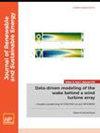太阳能驱动真空热离子发生器和循环多级热声驱动低温冷却器混合系统:基于能耗和突发事件的分析与优化
IF 1.9
4区 工程技术
Q4 ENERGY & FUELS
引用次数: 0
摘要
真空热离子发生器(VTIG)中浪费了大量优质热量,而这些热量可以作为热电联产应用中底层系统的原动力得到有效利用。为此,我们建立了一种新型环保混合系统,由定日镜太阳能场、真空热离子发生器和环形多级热声驱动低温冷却器(LMTC)组成,其中太阳能接收器的高温热源驱动真空热离子发生器发电,而 LMTC 则回收真空热离子发生器的余热以产生冷却负荷。该系统的热力学、经济和环境分析是基于放能和应急概念进行的。此外,还进行了参数研究,以评估设计参数对系统热力学、经济和环境标准的影响。最后,采用多标准 salp 蜂群优化算法和决策程序来提高能效,降低系统的成本和货币应急率,以及环境影响和生态应急率。研究结果表明,在系统可靠、优化运行的情况下,能效比可达 29.36%,最大功率为 17.2 MW,冷却负荷为 0.260 MW。系统成本和货币应急率可分别降至 0.059 美元/秒和 5.94 × 1010 seJ/秒,降幅分别为 10.6% 和 10%。此外,环境影响和生态应急率也分别下降了 6% 和 7.4%。这些理论发现可为太阳能固态热电联产系统的优化设计和实际运行提供指导。本文章由计算机程序翻译,如有差异,请以英文原文为准。
A hybrid solar-driven vacuum thermionic generator and looped multi-stage thermoacoustically driven cryocooler system: Exergy- and emergy-based analysis and optimization
Significant high-quality heat is wasted in the vacuum thermionic generator (VTIG), which can be efficiently utilized as a prime mover of a bottoming system for cogeneration applications. For this purpose, a new environmental-friendly hybrid system composed of a heliostat solar field, VTIG, and looped multi-stage thermoacoustically driven cryocooler (LMTC) is established, in which the high-temperature heat source of the solar receiver runs the VTIG to generate power, and the LMTC recovers the waste heat of the VTIG to produce a cooling load. Thermodynamic, economic, and environmental analyses of the system are carried out based on exergy and emergy concepts. Moreover, a parametric study is performed to assess the effect of design parameters on the system's thermodynamic, economic, and environmental criteria. Finally, the multi-criteria salp swarm optimization algorithm and decision-making procedures are conducted to improve the exergetic performance and decrease the system's cost and monetary emergy rates along with the environmental impact and ecological emergy rate. Findings depict that at the reliable, optimal operation of the system, the exergetic efficiency can reach 29.36% with a maximum power of 17.2 MW and cooling load of 0.260 MW. The system's cost and monetary emergy rate can be reduced to 0.059 $/s and 5.94 × 1010 seJ/s, with 10.6% and 10% reductions, respectively. Moreover, the environmental impact and ecological emergy rates decline by 6% and 7.4%, respectively. The theoretical findings may offer guidance for the optimum designing and practical running of such a solar solid-state cogeneration system.
求助全文
通过发布文献求助,成功后即可免费获取论文全文。
去求助
来源期刊

Journal of Renewable and Sustainable Energy
ENERGY & FUELS-ENERGY & FUELS
CiteScore
4.30
自引率
12.00%
发文量
122
审稿时长
4.2 months
期刊介绍:
The Journal of Renewable and Sustainable Energy (JRSE) is an interdisciplinary, peer-reviewed journal covering all areas of renewable and sustainable energy relevant to the physical science and engineering communities. The interdisciplinary approach of the publication ensures that the editors draw from researchers worldwide in a diverse range of fields.
Topics covered include:
Renewable energy economics and policy
Renewable energy resource assessment
Solar energy: photovoltaics, solar thermal energy, solar energy for fuels
Wind energy: wind farms, rotors and blades, on- and offshore wind conditions, aerodynamics, fluid dynamics
Bioenergy: biofuels, biomass conversion, artificial photosynthesis
Distributed energy generation: rooftop PV, distributed fuel cells, distributed wind, micro-hydrogen power generation
Power distribution & systems modeling: power electronics and controls, smart grid
Energy efficient buildings: smart windows, PV, wind, power management
Energy conversion: flexoelectric, piezoelectric, thermoelectric, other technologies
Energy storage: batteries, supercapacitors, hydrogen storage, other fuels
Fuel cells: proton exchange membrane cells, solid oxide cells, hybrid fuel cells, other
Marine and hydroelectric energy: dams, tides, waves, other
Transportation: alternative vehicle technologies, plug-in technologies, other
Geothermal energy
 求助内容:
求助内容: 应助结果提醒方式:
应助结果提醒方式:


